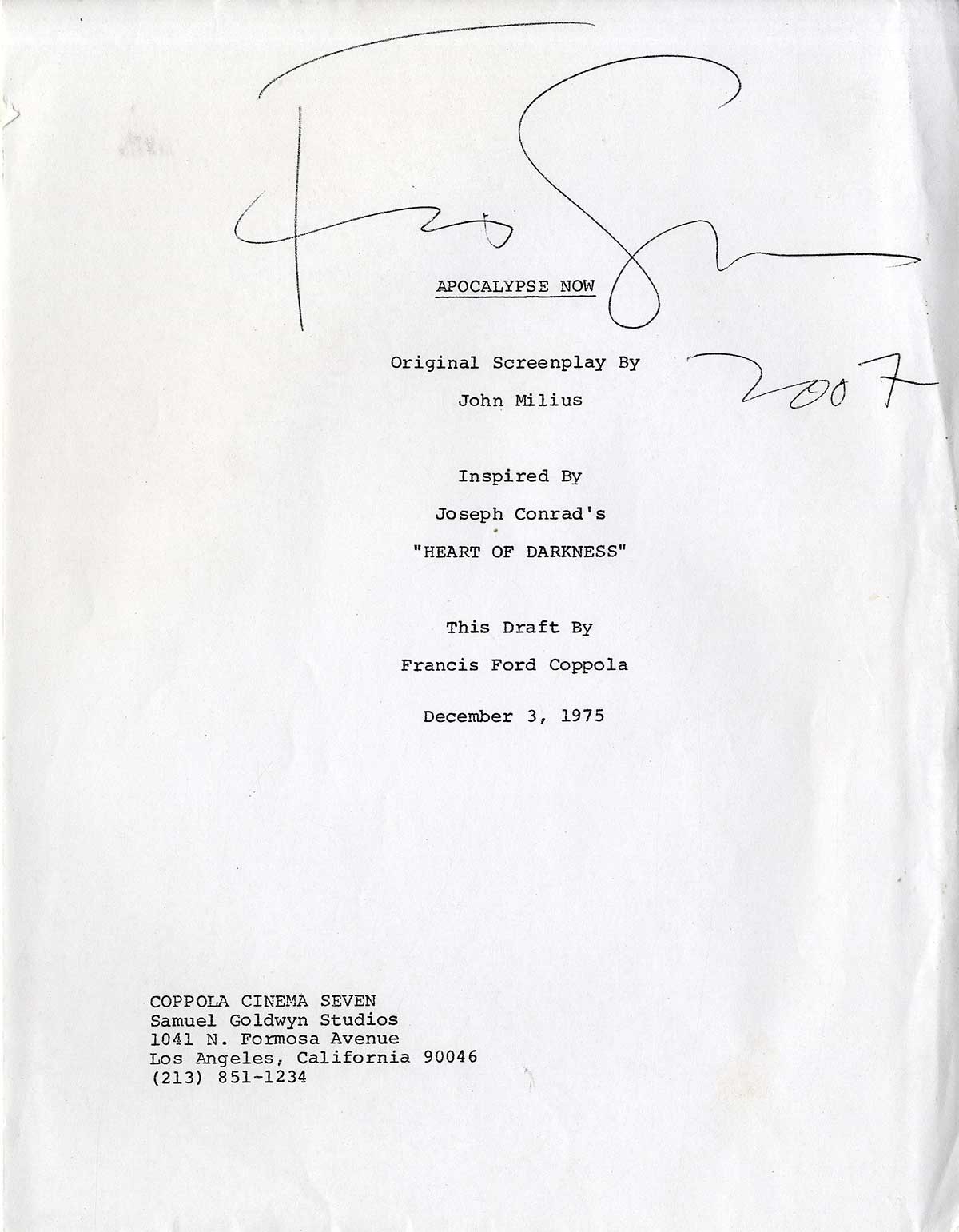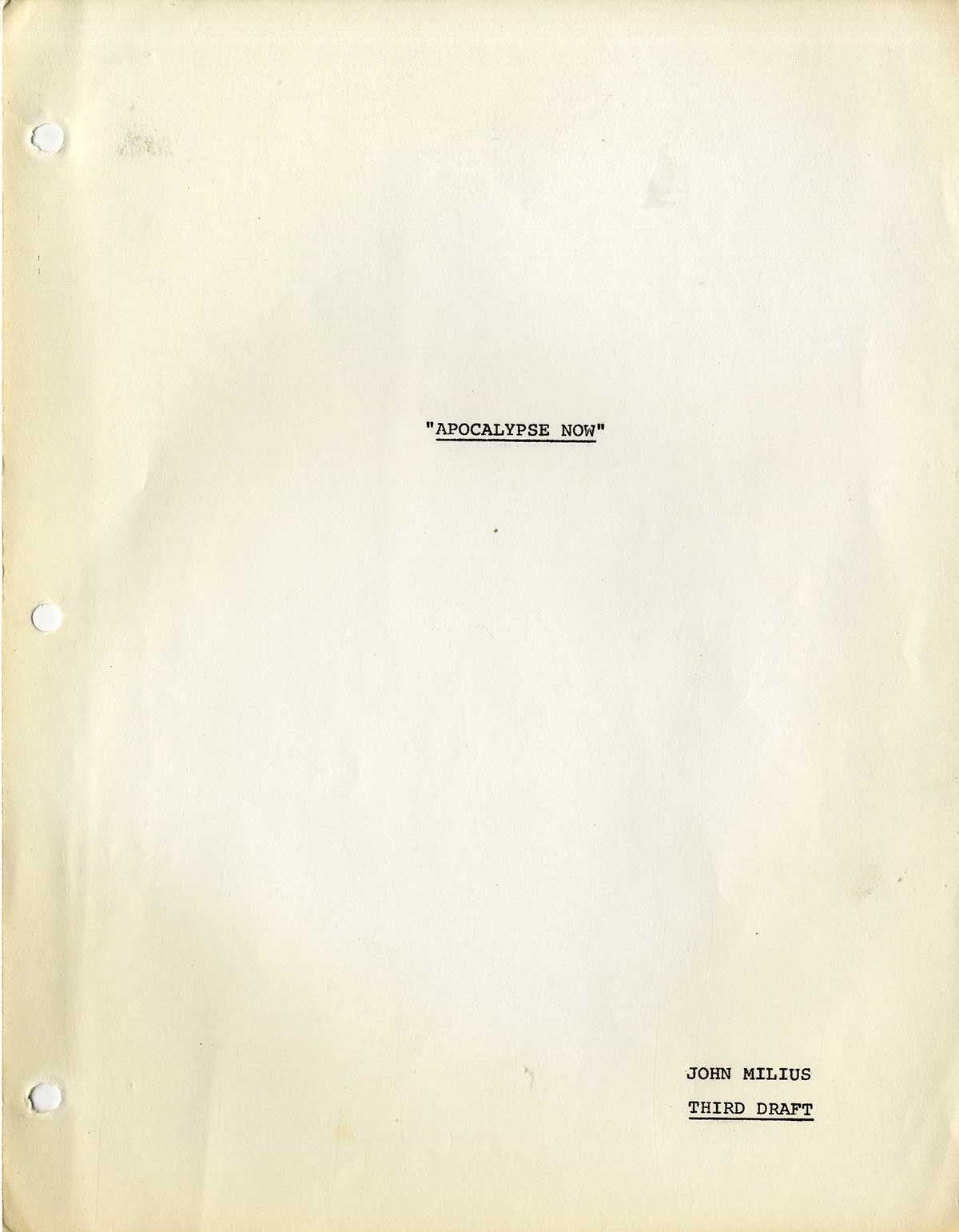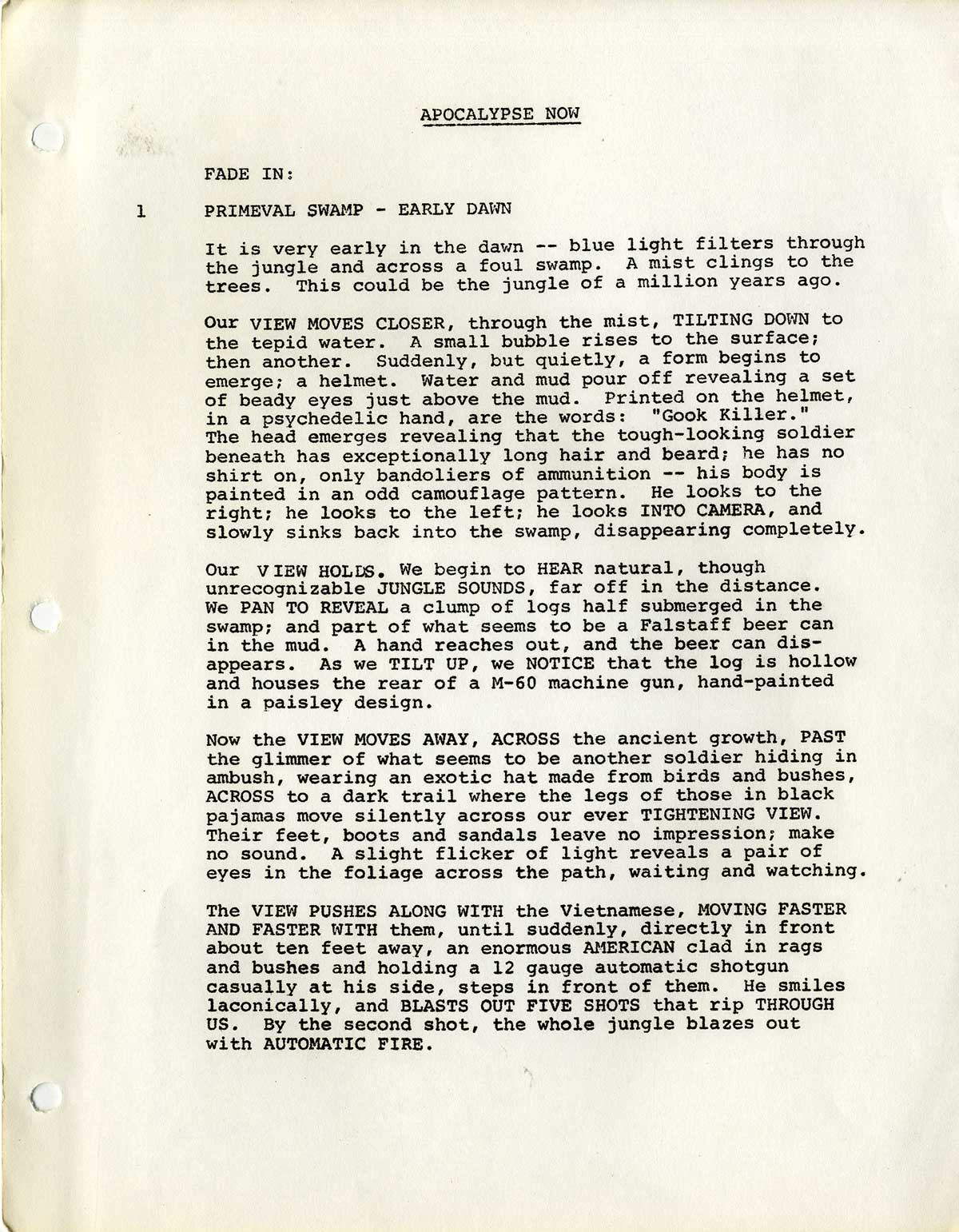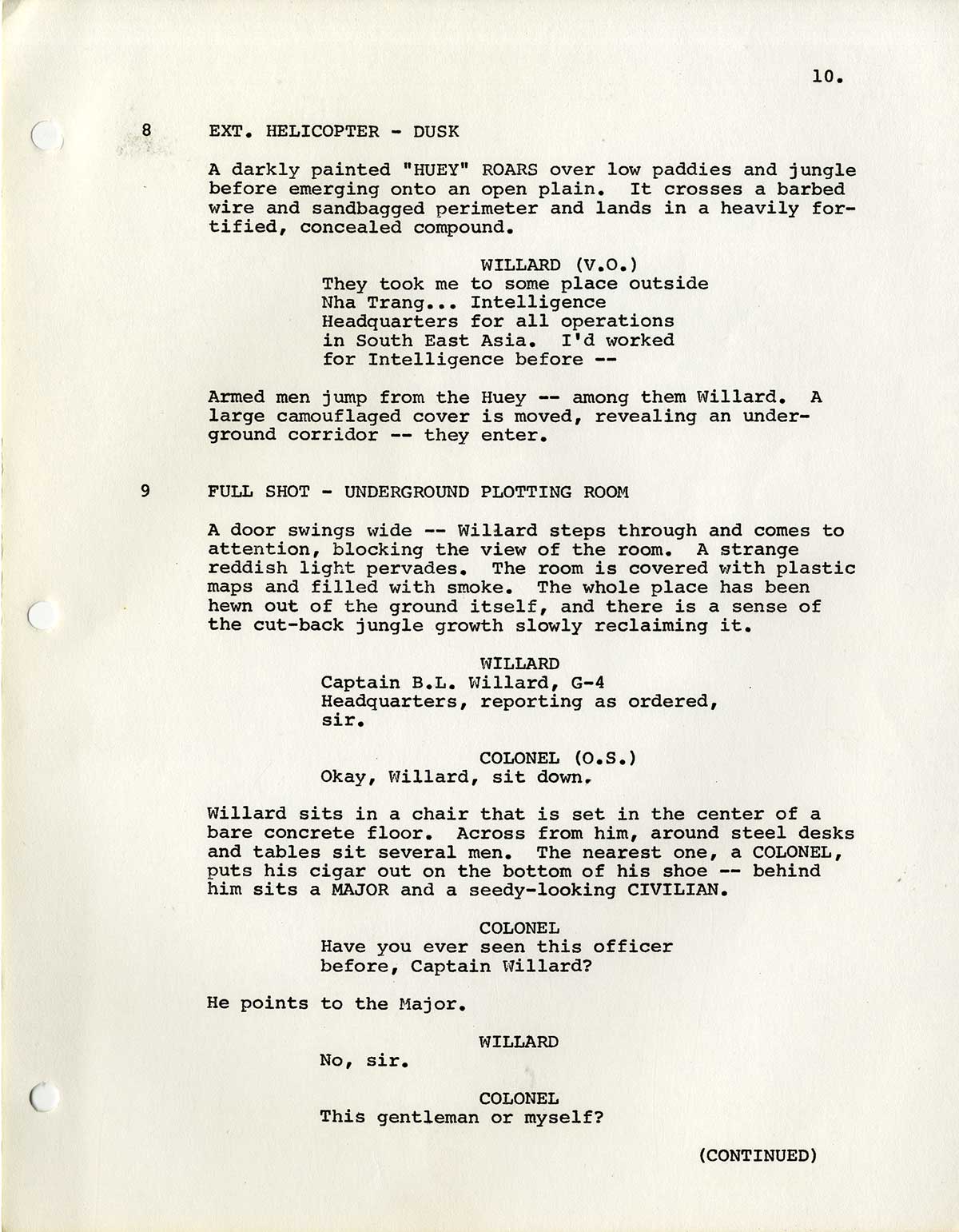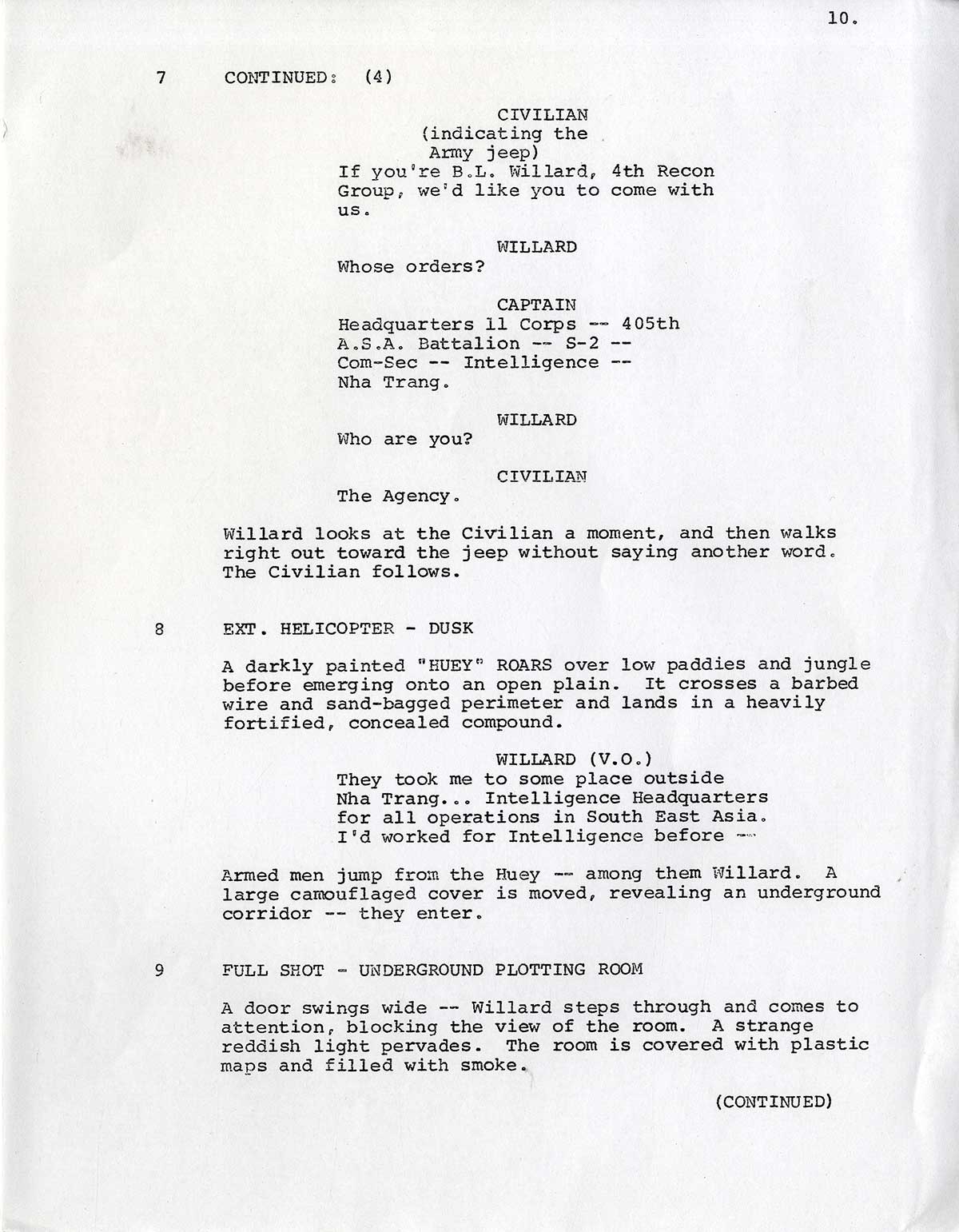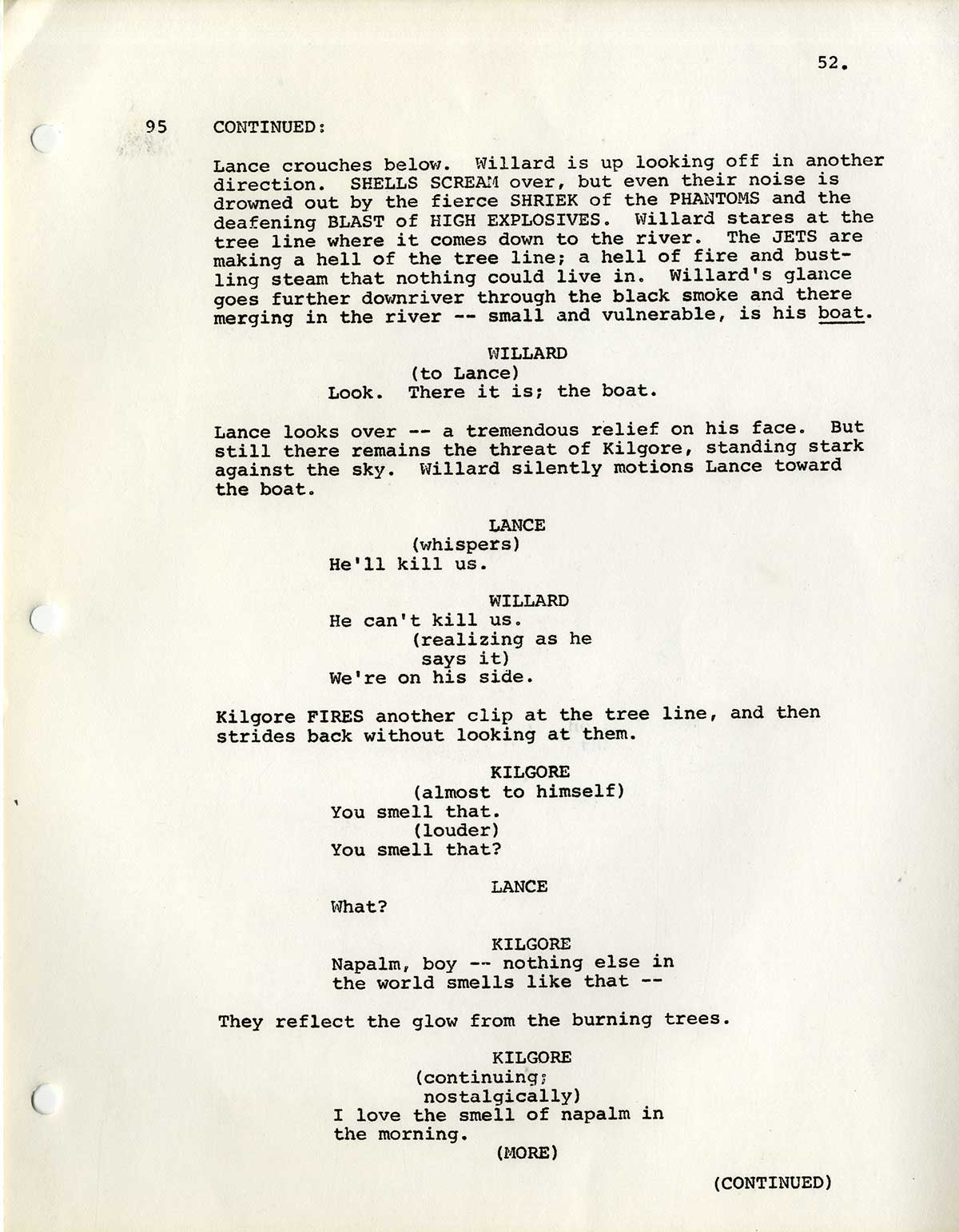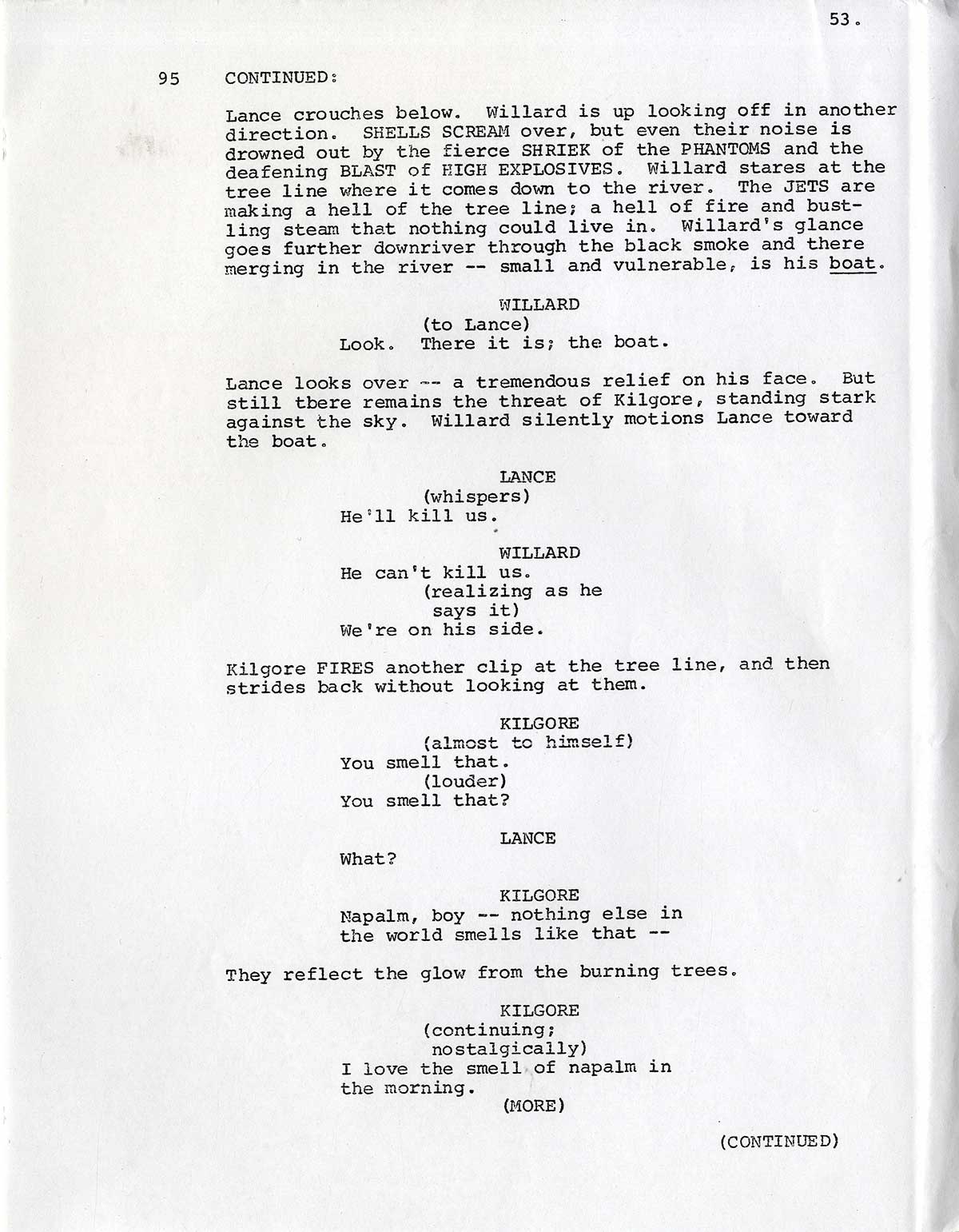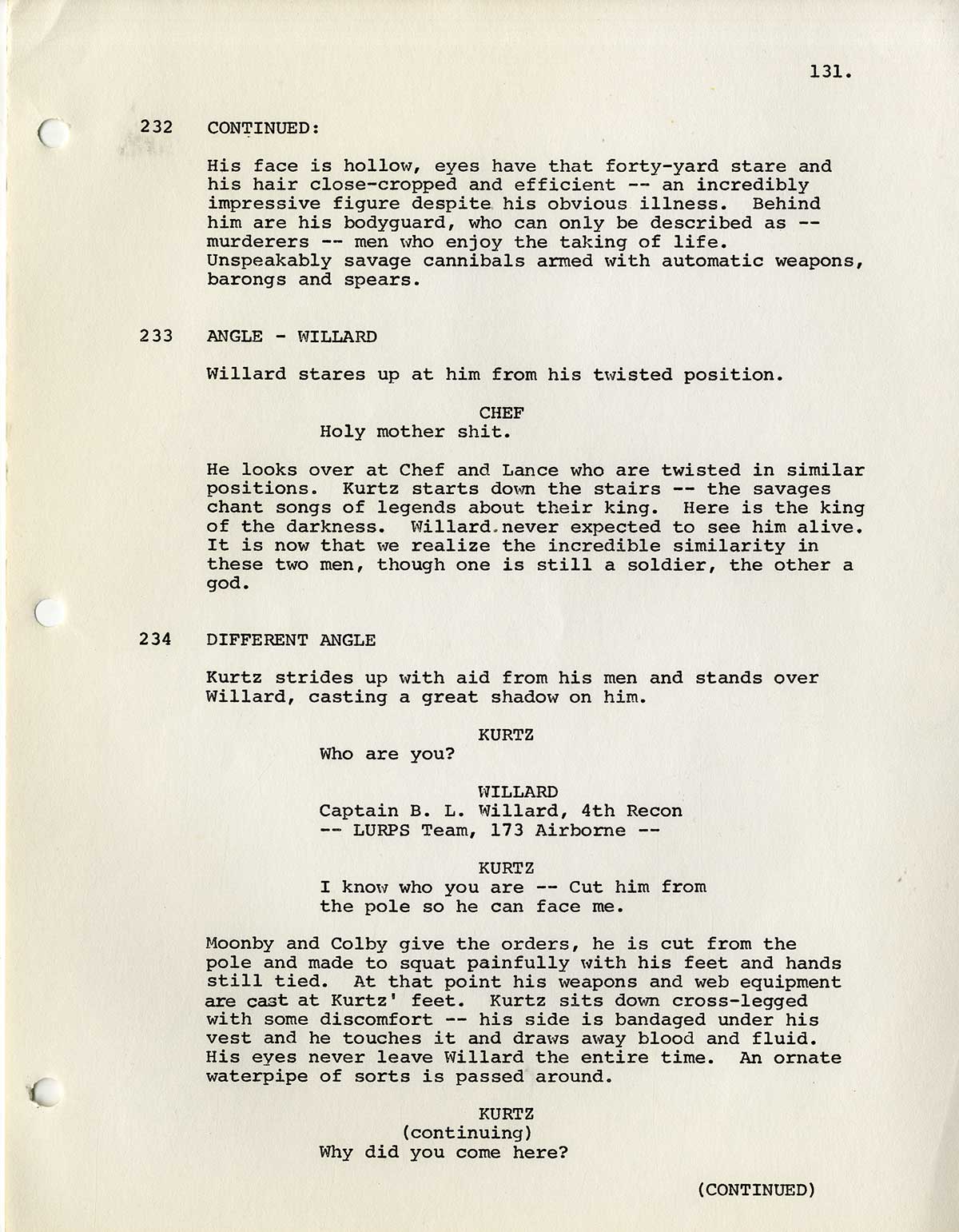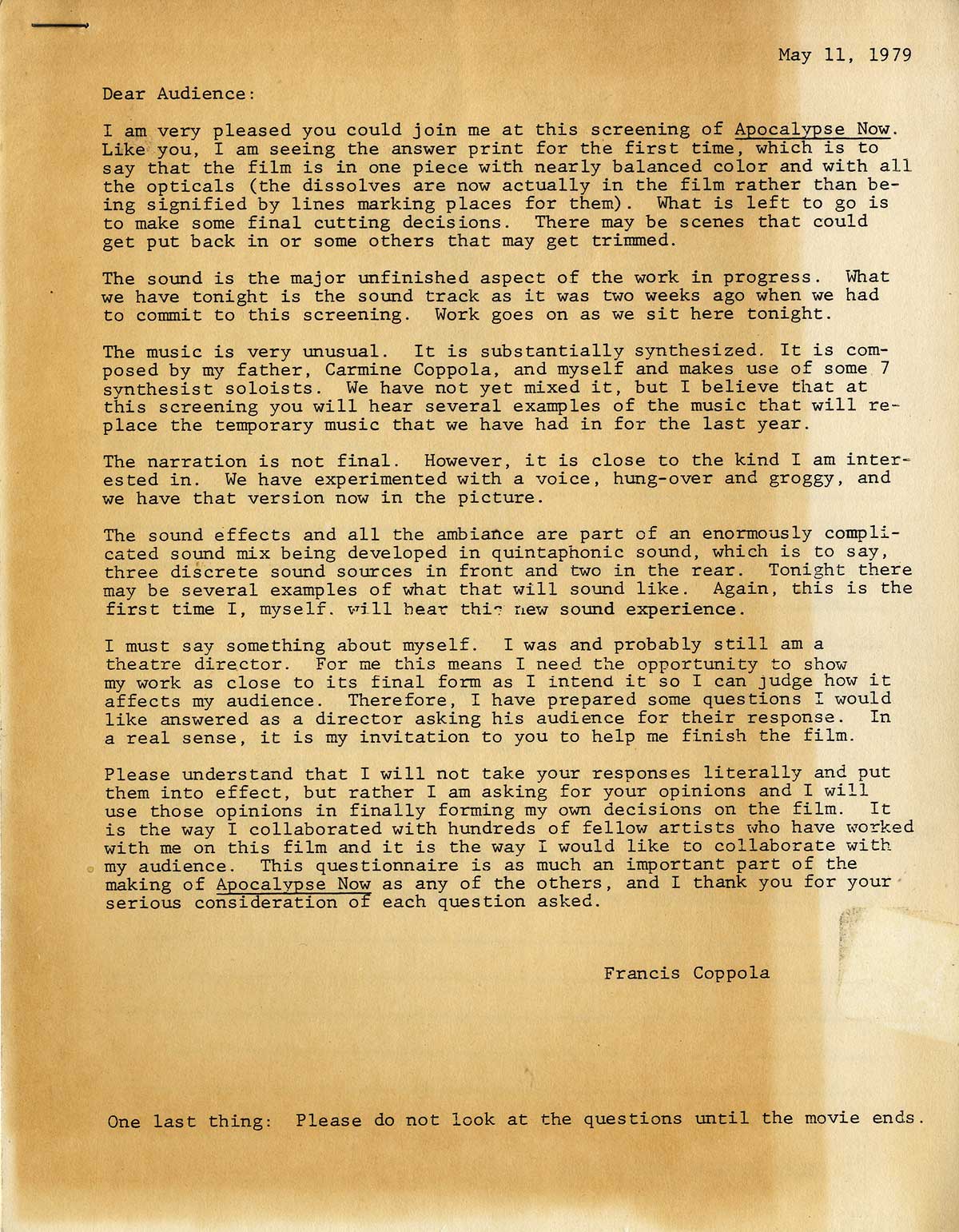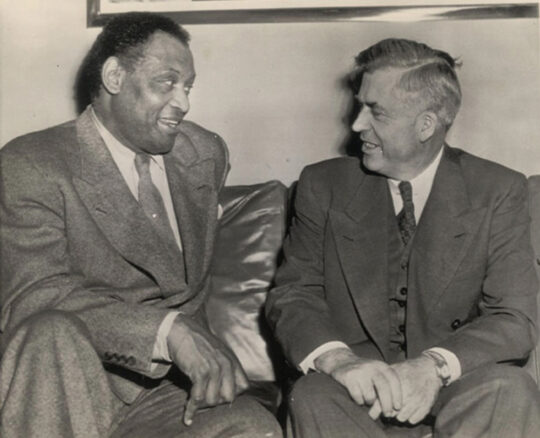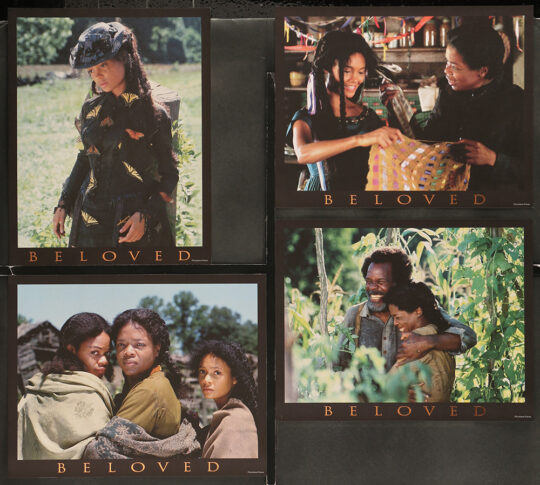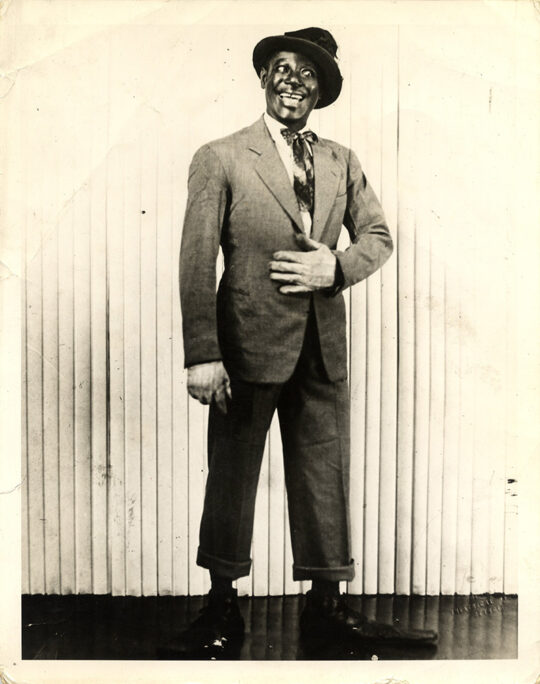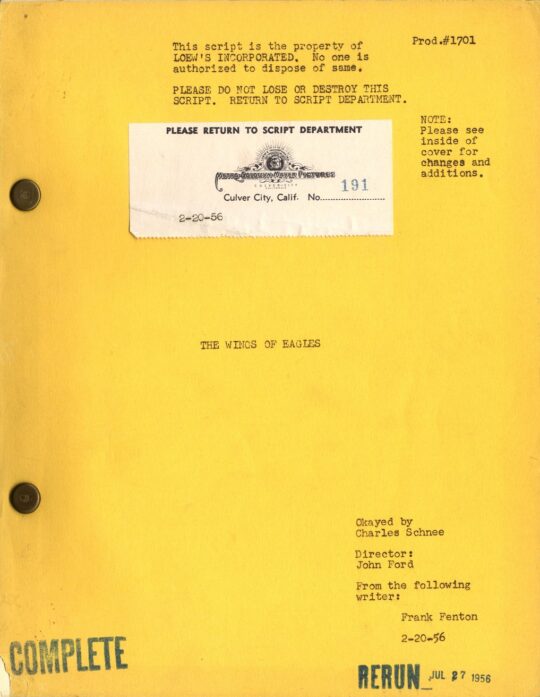APOCALYPSE NOW (1979) Third Draft Screenplay by John Milius, Revised by Francis Coppola, Dec 3, 1975
Hollywood: Coppola Cinema Seven, 1975. Printed wrappers, brad bound, 154 pp. of mimeographed script, with numerous pages of revisions laid in loosely. An extra title page denoting “Coppola’s December 3, 1975” is laid in loosely, and signed and dated by Coppola. Slight creasing to the revision pages, NEAR FINE. Also included is a 4 page questionnaire given to a preview audience on May 11, 1979, front page tanned, VERY GOOD.
As most of the movie’s fans already know, John Milius’s Vietnam War screenplay, APOCALYPSE NOW, inspired by Joseph Conrad’s 1899 novella, Heart of Darkness, was originally going to be directed by George Lucas, with Francis Coppola producing (just as Coppola had produced Lucas’ AMERICAN GRAFFITI). Due to a number of factors, including Lucas’ involvement in STAR WARS, and Coppola’s increasing interest in the project, it became a film by Francis Ford Coppola and is now considered an American masterpiece.
By the time APOCALYPSE NOW was produced, screenwriter John Milius (b. April 11, 1944 in St. Louis, Missouri) had already made a name for himself as the original screenplay writer of Don Siegel’s DIRTY HARRY (1971), John Huston’s THE LIFE AND TIMES OF JUDGE ROY BEAN (1972), and Sidney Pollack’s JEREMIAH JOHNSON (1972), among others, as well as writing and directing DILLINGER (1973) and THE WIND AND THE LION (1975) – all of them notable for the larger-than-life quality of their principal characters. APOCALYPSE NOW was an early Milius project, conceived by him in response to a college English professor who challenged his class by saying, “No screenwriter has ever perfected a film adaption of Joseph Conrad’s Heart of Darkness.” Milius’s original draft, purportedly written in 1969, transposed the action of Conrad’s story to present-day Vietnam (an inspired concept) and was titled “The Psychedelic Soldier.”
The most immediately noticeable difference between this third draft screenplay and the completed film is the lack of the distinctive voiceover narration written after the movie was shot by Michael Herr (known for his Vietnam War memoir, Dispatches), and spoken by Martin Sheen who plays its protagonist, Captain Willard (although the Milius screenplay does include some, less interesting, voiceover). Milius had intended his APOCALYPSE NOW screenplay to be a black comedy, not unlike the screenplay he co-wrote for Steven Spielberg’s 1941, however, as developed by Coppola, the project turned into something more visionary and dream-like, in the manner of Werner Herzog’s 1972 jungle epic, AGUIRRE, THE WRATH OF GOD. AGUIRRE not only influenced the look and feel of Coppola’s Vietnam film (both are largely about boats traveling up or down river), but very likely inspired its hypnotic synthesized score.
This third draft screenplay is, in fact, a rough version of the film that was eventually made. All of the film’s main characters and sequences are present, along with a lot of the film’s choicest dialogue, but much else was revised between this draft and the completed movie. For example:
- The screenplay’s opening bears little resemblance to the Saigon opening of the movie. The first image is a soldier rising from the “primeval swamp” in killer mode, much as Captain Willard will do at the movie’s conclusion. Milius’s opening also sets up an unfilmed framing sequence (paralleling the framing device of Joseph Conrad’s original story) with Captain Willard on a yacht in California’s Marina del Rey recalling in flashback Vietnam and his encounter with Colonel Kurtz.
- Beginning the flashback, Willard receives his assignment from military intelligence to travel upriver and terminate Colonel Kurtz “with extreme prejudice.” This sequence is more or less the same as in the film, but the characters in the movie describe a darker, more insane version of Kurtz, including playing back the tape recording of Kurtz’s (Marlon Brando’s) voice talking about his nightmare of watching “a snail crawl along the edge of a straight razor ….“
- USO show with Playboy playmates. This sequence is more elaborate as staged by Coppola than as described in the screenplay draft. It’s also the first major sequence in this screenplay after Captain Willard gets his assignment. In the movie, it comes after the Col. Kilgore/surfing sequence.
- The Col. Kilgore/surfing sequence is one of the most praised sections of the movie, thanks in large part to Robert Duvall’s flamboyantly macho performance as Col. Kilgore. Kilgore’s two most often quoted lines, “Charlie don’t surf,” and “I love the smell of napalm in the morning,” are both in this screenplay draft. So is the US helicopter raid on the Vietnamese village accompanied by Wagner’s “Ride of the Valkyries.” The biggest difference is in the character of the California surfer, Lance B. Johnson. (LBJ, get it?) In this draft, which we assume to be mostly Milius’s work, Lance is something of a wiseass. In Coppola’s movie, he becomes a symbol of innocence. In the screenplay, this sequence concludes with Lance and Willard stealing Kilgore’s surfboard, a bit of business not included in Coppola’s original APOCALYPSE NOW cut, but which one can see in his later APOCALYPSE NOW REDUX cut.
- Traveling further upriver, we have the business with Chef (Fredric Forrest) and the tiger, and the reappearance of the Playboy Bunnies. This is probably the most sexist sequence in the screenplay, with the Bunnies offering sex in exchange for helicopter fuel, and Coppola was wise not to include it in his original APOCALYPSE NOW cut, although it does appear in the APOCALYPSE NOW REDUX cut. At least, in Coppola’s rewritten movie version, Coppola makes an effort to give the girls some character.
- The Do Lung Bridge sequence – This is a surreal and chaotic sequence, as written. As filmed by Coppola, it becomes even more surreal and chaotic, adding the element of surfer Lance taking LSD before debarking (the scene plays like an acid trip) with the overriding theme of no one knowing who’s actually in charge. In the movie, Willard asks one of the soldiers shooting at the Vietcong who the Commanding Officer is, and he replies, “I thought you were.” The screenplay line, “This is the cesspool of hell,” is changed in the movie to “This is the asshole of the world.”
- The French plantation sequence – This is a wonderfully written and played sequence showing how French imperialism preceded American imperialism in Southeast Asia. Coppola rightly thought it was a little too long for his original APOCALYPSE NOW cut, and that it slowed the movie down, but one can view it in his later APOCALYPSE NOW REDUX cut. One big change – in the screenplay, one of the Frenchwomen offers Willard sex; in the movie she offers him opium.
- The Col. Kurtz sequence – Arriving at Kurtz’s compound in the heart of the jungle, Captain Willard and his remaining crew are met by an Australian. (In the movie, he is an American photojournalist played by Dennis Hopper.) This is the section of the movie that was most extensively reworked by Coppola – with the likely collaboration of Marlon Brando, who played Kurtz – between this draft and the completed film. The screenplay has none of Brando’s most famous lines (“You are an errand boy sent by grocery clerks to collect a bill“), and does not include the film’s climax in which Willard’s assassination of the mad Kurtz is intercut with the jungle villagers’ ritual slaughter of a bull. The screenplay draft ends with a scene, borrowed from Conrad’s novella, in which Willard, having returned home, meets with the late Kurtz’s widow. There is no such scene in the completed film.
Out of stock

